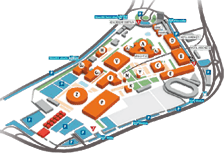URBIS TECHNOLOGY
23.-27.4. 2013
The international Fair for Communal Technology and Services

Investors are again showing interest in the free areas of cities and villages
Investments are a major source of money for cities and municipalities. The biggest problem is that the regions are not visible, they not present themselves, investors do not learn about the possibilities offered. Therefore, municipalities should cooperate with developers or a real estate agency. There is also generally lack information about free zones as well. This was stated by Klára Fitsch, coordinator of Panattoni Czech Republic Development s.r.o.
She pointed out that the boom in this area existed before the crisis in 2008 and currently, investor interest is growing again. Particularly among companies from the automotive industry. These include companies from Germany, but also from Japan and the USA. These companies have understood that it is not worth investing in Western countries. Filip Kozák, director of CBRE industrial agency added, that demand is driven mainly by manufacturing companies, and less by distribution and storage. "Last year was decent in terms of cities and towns, investors have once again begun to show interest in open areas. Further development depends on what happens in the Eurozone, and how German economy will thrive," said Kozák.
He pointed out that in 2012, the industrial market showed the second lowest amount of completions since 2004. A total of 14 industrial or business parks across the country offers more than 5000 m2 of open spaces. Thus, the vacancy rate rose slightly for the first time since 2009. The highest demand (90 percent) was recorded in Prague and surroundings and in South Moravia, then Pilsen and the Central Bohemia Region. "The demand was mainly driven by the automotive industry in the 4th quarter of 2012.
Construction of seven buildings Began with a total size of 99,900 square metres. Despite pessimistic predictions and weaker confidence in the economy, 2012 was perceived as very good for the industrial market in the Czech Republic. Total leasing demand (CRP) and net demand realized were even higher than in 2011," said Kozák. New premises were rented primarily by companies already operating on the Czech market who expanded or relocated. Therefore, we recorded a growing number of secondary spaces, which become difficult to rent again, especially in very competitive regions.
In 2012, demand for pre-lease spaces dominated, mainly due to lack of available space in some regions and limited construction on a speculative basis. Developers are in most cases waiting for pre-lease before construction.
New sites where all permits are available are currently in preparation and waiting for tenants. Rents remained stable in most regions and even increased in some cheaper areas. While banks and investors generally require a longer lease, landlords are under increasing pressure from tenants to offer contracts for shorter periods of time. Currently, the Czech Republic has 4.11 million square metres of industrial space intended for rent. In 2012, approximately 212,600 square metres in twenty halls were completed; 91 percent of the spaces have been pre-rented.
Building is currently taking place
on more than 219,500 square metres in nineteen halls with planned completion in
2013, and already 83 percent of the space is pre-rented.
Composition of net realized demand in 2012 was as follows: pre-leases accounted
for 43 percent, 34 for new leases and 23 percent for expansion. The average
size of a transaction in 2012 reached 4,700 square metres, which was in line
with the long-term average. Fifteen transactions (without renegotiation)
exceeded 10,000 square metres - of which nine were pre-leases.




